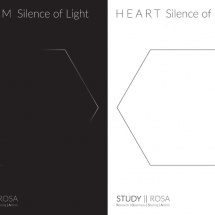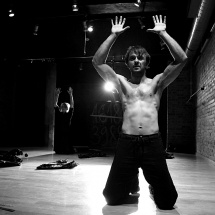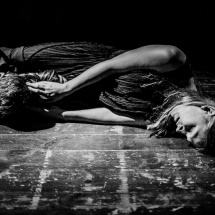Duet ON SILENCE
-
TAZM Silence of Light
-
HEART Silence of Polygon
-
DWUGŁOS O CISZY – SPEKTAKLE
-
TAZM Milczenie światła
-
SERCE Cisza wieloboku
The Duet ON SILENCE, composed of STUDY || ROSA’s twin performances: TAZM Silence of Light and HEART Silence of Polygon, is an attempt to confront the paradox of speaking about what cannot be put into words. And not just because when you pronounce this ‘oddest’ of words – silence – you destroy it, as the poet Wisława Szymborska would say. Although it is often impossible to speak about human and animal suffering because it is too far from words and paralyzing, one must not be silent about it. But then – to utilize Samuel Beckett’s question – ‘what is the Word’?
The efficacious artwork leaves silence in its wake.
Susan Sontag: Aesthetics of Silence
TAZM and HEART talk to each other and intersect on spatial and thematic planes as well as in terms of poetics. But the quality which connects them above all else is silence. TAZM begins with a soliloquy on silence, with a request for it; HEART ends by bringing silence to an end.
The first performance is vertical, masculine, played in the depths of the space; the second is feminine, horizontal, played across its width. The first is from Maciej Zakrzewski, the second from Maria Bohdziewicz, principal actors and collaborators at STUDY || ROSA. The first performance is based on narrative, on a true story about a life destroyed forever and attempts to maintain and restitute humanity. The second has a play as its base; a play that depicts a fictional – although likely, given the turmoil of war – story of injustice and hatred, whose destructive power should be brought to an end in the next generation. Since this turns out to be possible, at the end of the Duet a note of hope resonates gently in another key, like a lullaby.
We need this hope while we are at a crossroads. After the twilight of grand narratives, only a few small ones have remained available for us in the niches. Everywhere spectacle, a show with the associated element of drama, has been holding sway. Drama is no more than a game, a shoot ‘em up game, a game of slaughter. Who with whom? Who against whom? Who to whom?… Who under whom?…
We are at a crossroads indeed. It is estimated that our children’s generation, the first for centuries, will have shorter lives than us. Their physical capacities are falling dramatically as time spent in front of screens of all types grows and as communing with someone else’s words diminishes (everybody speaks, no-one listens; everyone writes – for instance blogs – nobody reads). Above all, communing with literature, with poetry, is disappearing rapidly. And with song (not with pop songs of course). All the indications are that the creativity of successive generations (how many it is hard to predict) will decrease as a consequence of the progressive atrophy of the poetic imagination. From a long-term perspective, it is probably the natural order of things. After the light yang of the age of reason there comes the dark yin of absorption and listening to what this reason actually offers us. In other words, after the extremely rapid advances in the technical field, which creates stunning access to knowledge and communication, there must be time – seen as a counter-movement – to assimilate and discriminate as to how to take advantage of these opportunities. Let it be done with reason…
We need stories that with the natural rhythm of the tides allow scenarios of behaviour to seep into and install patterns of relationships within us. Drama and games do that too, but differently – through conflict, through bursts of ruptures and reconciliations. Storytelling and tales are like the voices of living grandmothers or grandfathers which whisper homeopathic words directly into the ear of a granddaughter or grandson that have the power to immunize. These voices fade away and we – deafened by the media clamor, often adding to it – hear less and less.
We need stories – as Peter Brook says – but not gossip. The story of a Tazmamart prisoner who survived because he was visited in his cell by an angel or maybe just a sparrow, or the story of a mother in Scorched who was raped by her own son and gave life – in pain and horror – to twins, and then in her will bequeathed them the fight for adulthood – these stories carry inside themselves the seeds of tragedy. The tragedy of responsibility, the tragedy of being in response. A tragedy to be played in the theatre – this anthropological machine that teaches us to see and hear, to speak and understand.


